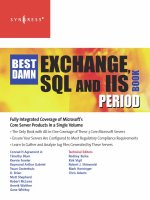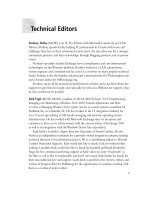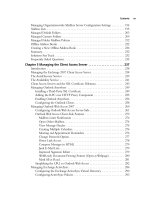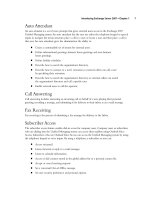Exxhange SQL And IIS- P10 pps
Bạn đang xem bản rút gọn của tài liệu. Xem và tải ngay bản đầy đủ của tài liệu tại đây (390.84 KB, 5 trang )
12 Chapter 1 • Introducing Exchange Server 2007
Database Recovery Management
This tool is used to manage disaster recovery scenarios. It can help reduce recovery time and
streamline the recovery process after database problems occuur on production servers running
Microsoft Exchange Server.
Database Troubleshooter
This tool is used to help troubleshoot store mounting and other database-related problems.
Mail Flow Troubleshooter
This tool is used for troubleshooting mail fl ow and transport-related problems.
Message Tracking
This tool is used for examining message tracking logs.
Queue Viewer
This tool is used for managing Exchange mail queues.
Performance Monitor
This tool is used for monitoring server performance and overall health.
Performance Troubleshooter
This tool is used for troubleshooting server performance problems.
NOTE
A cool thing about the Toolbox work center is that it’s extensible; meaning
additional tools can be added via the Microsoft Exchange Eeb site. It would have
been cooler if 3rd party tools could have been added to the Toolbox center as
well, but unfortunately it’s limited to Microsoft’s own Exchange tools.
New Wizards
The Exchange Product Group also included some new wizards in an effort to get rid of the older
Exchange System Manager internally (see Figure 1.4).
Introducing Exchange Server 2007 • Chapter 1 13
Exposed CMDlet Code
The EMC is built on top of the Windows PowerShell engine (formerly known as Monad), which
ultimately means that the GUI wizards are just executing shell cmdlets in the background. Each
executed wizard task in the user interface exposes the actual cmdlet code when the wizard has
completed (see Figure 1.5). The cool thing about this is the fact that you can copy the exposed
code to your computers clipboard, paste it to a text editor such as Notepad, edit it, and save it as
a PS1script and/or paste it direct into the EMS to execute immediately.
Figure 1.4 Exchange 2007 Wizard
14 Chapter 1 • Introducing Exchange Server 2007
Here is the cmdlet, including the necessary parameters for enabling Outlook Anywhere:
enable-OutlookAnywhere –Server:‘EDFS03’ –ExternalHostname:‘mobile.exchangehosting.dk’ –
ExternalAuthenticationMethods:‘Basic’ –SSLOffl oading:‘$false’
EMS
The Exchange Product Group included an EMS (see Figure 1.6) in order to make the Exchange
Administrator’s job easier. The new EMS is based on Windows PowerShell (formerly known as
Monad). By using this new shell you can accomplish all of the tasks available in the EMC. The shell
is there to make it easier to do bulk and/or repetitive administrative tasks.
Figure 1.5 Exposed CMDlet Code
Introducing Exchange Server 2007 • Chapter 1 15
HA Improvements
The availability requirements for messaging and collaboration servers have increased drastically over
the years, catapulting these servers to be amongst the most mission-critical servers in the datacenter.
Several recent reports have concluded that e-mail is more important to end users than their phones.
So, it’s in your best interest as the Exchange Administrator to achieve as high an uptime as possible.
Each of these facts played an important role when the Exchange Product Group developed Exchange
Server 2007, so it should come as no surprise that HA and disaster recovery was of utmost concern,
and the reason behind the many improvements and new functionality in the Exchange Server 2007
product. Most especially is the new continuous replication functionality, which uses log fi le shipping
and replay to keep a second copy of a Mailbox database in sync with the production database.
Figure 1.6 EMS
TIP
To get up to speed with the new EMS, I recommend you study the following two
Microsoft PDF fi les, which give you a pretty good primer on use and functionality:
Introduction to the Exchange Management Shell: www.microsoft.com/downloads/
details.aspx?familyid=1dc0f61b-d30f-44a2-882e-12ddd4ee09d2&displaylang=en
Exchange Management Shell Quick Reference: www.microsoft.com/downloads/
details.aspx?familyid=01A441B9-4099-4C0F-B8E0-0831D4A2CA86&displaylang=en
16 Chapter 1 • Introducing Exchange Server 2007
LCR
LCR is a solution that uses the new continuous replication technology introduced in Exchange
Server 2007. LCR is a new functionality that uses built-in asynchronous log shipping and log replay
technology to create and maintain a replica of a storage group on a second set of disks that are
connected to the same server as the production storage group. The interesting thing about LCR
is that it only requires one Exchange Server 2007 with the Mailbox Server role installed. However,
it does require that there only be one viable database in each storage group.
CCR
The most interesting new feature when it comes to HA is the CCR solution, which, like LCR, uses
the new Exchange Server 2007 continuous replication technology. CCR is a clustered solution that
eliminates the single point of failure that exists in traditional Exchange cluster setups. This is done
by maintaining a copy of the database on the active node; in the event of a database corruption, this
allows both services and databases to fail over to the passive node. CCR can only be deployed in
a two-node active/passive cluster. (LCR and CCR are covered in more detail in Chapter 8).
Exchange Server 2007 Services
The services used by the different Exchange Server 2007 roles are either completely new services or
services that have changed since Exchange 2003. Table 1.1 lists each of the Exchange Server 2007
services along with a short description.
Table 1.1 Exchange Server 2007 Services
Service Description
Exchange Active This service provides Active Directory topology information
Directory Topology to Exchange services. If this service is stopped,
Service most Exchange services cannot start.
Microsoft Exchange This service provides the ADAM directory service function
ADAM to the Edge Transport Server.
Microsoft Exchange This service manages the credentials that the Hub
Credential Service Transport Server uses to authenticate to ADAM for
a subscribed Edge Transport Server.
Microsoft Exchange This service provides data replication and synchronization
EdgeSync between Active Directory and ADAM for a subscribed
Edge Transport Server.
Microsoft Exchange This service provides fi le distribution services.
File Distribution
Microsoft Exchange This service provides IMAP4 services to clients. If this
IMAP4 service is stopped, clients cannot connect to the computer
using the IMAP4 protocol.









